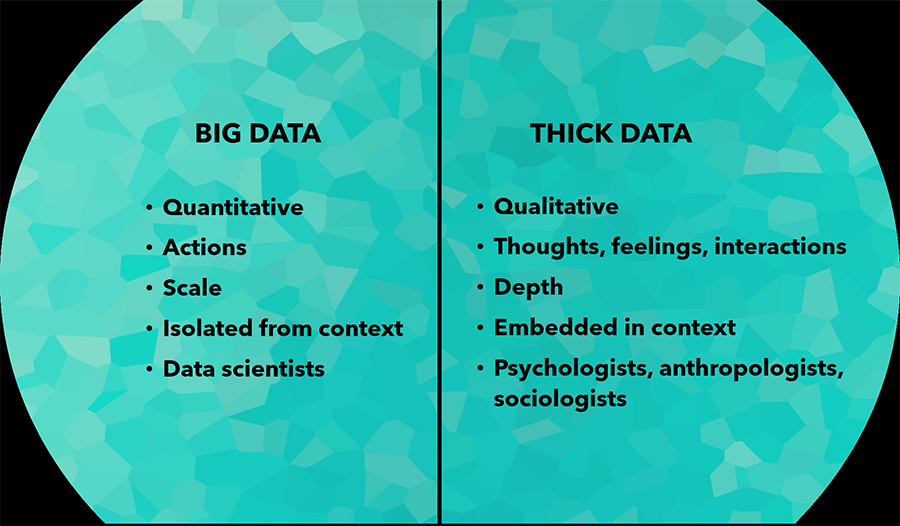Why is Thick Data Important for Consumer Research in India?
Consumption is a part of life and thus cannot be explored in a detached and isolated manner. People are living slices of their lives while interacting with products offered to them by marketers. As consumer researchers, we need to understand how products can be meaningfully embedded in people’s lives. Thick data is a type of research that follows ethnographic immersion into the consumer’s natural lived experience. It allows an opportunity to go beyond the obvious and delve into the layers of complexities that define an individual. Thick data is excavated through empathy. It delves into people’s personal stories, experiences, interactions, and emotions. It is based on the method of thick description developed by anthropologist, Clifford Geertz.

On the other hand, thin data includes surface-level observations of behavior. Big data comprises thin data—quantitative data, capturing (real-time) actions of consumers, such as, what they have browsed online, what links they clicked, what they added to their cart, what they bought, what they didn’t buy, etc. While capturing these thin actions can provide patterns to marketers, big data is unable to understand the thick human and contextual antecedents of people’s actions—such as, thoughts, feelings, and interactions. The major difference between thin (big) data and thick data is their approach to “context”. Big data captures consumer actions and isolates these actions from the rich, lived experience of the person. Whereas, thick data focuses on consumer experiences embedded in their real life—the subtle sensorial, and cultural forces that are influencing their worldviews, and their interactions with the social and material worlds that surround them.
But why is “Context” so important to understand the Indian consumer?
As highlighted above, consumption practices are a part of our everyday routine. Yet often our exploration of consumer behaviour is done in an isolated manner where we zoom into this one aspect without making any considerations of how other aspects of a person’s everyday routine might or might not be impacting it. To really understand a person’s consumption behaviour, it becomes important to invest in learning about a person’s routine, aspirations, vision, hope, fears etc. It’s necessary to understand where does a brand or product fit into their lifestyle, what needs does it fulfil or what emotions does its usage arouse. All this forms a part of what we can refer to as context. Often choices and decisions are deeply embedded in cultural practices even when people might have developed an extremely rational logic of justifying it. It is only by delving into the context can we sometimes fall upon those deeper thoughts and emotions of a person.

Further, the anthropologist, Edward T. Hall had introduced the concept of high-context vs. low-context cultures in 1959. High context cultures are defined by people’s reliance on contextual cues to make sense of interpersonal communication and to structure their actions. These contextual cues include subtle, indirect, unspoken cues—including the knowledge of each other’s histories and cultural background. Whereas, low-context cultures rely on more explicit, direct and verbal modes of communication—where all the information is communicated elaborately through explicit words. With India being a high-context culture, people’s actions are heavily influenced by their contexts. Below, we highlight four ways in which context influences consumer behavior in India, and how thick data can potentially capture its influence:
1. Diversity
Anyone who has lived or visited India would be aware of how heterogeneous its population is. In every city, people from all across the country are living together. Whenever an Indian meets another Indian for the first time, they ask, “Where are you from?” This question is not mere small talk. It is a very important means that will help the person create a mental profile of the other person. Regional and linguistic diversity often play an important role in shaping a person’s identity. To understand a consumer, thus requires, that one understands in depth about their context. One listens and learns about their lifestyle.
For instance, there is enough in the popular mainstream media about how vastly different are the north and south parts of India with respect to culture. There are different rituals, food preferences, humor, cinema etc. Pan-Indian brands frequently face transitivity hurdles between north and south India. Just because some products and advertisements are highly successful in north India, we can’t be sure that they will be equally successful in other parts of the country too. Thick data provides an opportunity to understand these nuances that are deeply embedded in a person’s culture. They allow us a chance to go beyond the obvious and delve into the more rooted aspects of their lifestyle.
2. Collective experiences
It’s important to acknowledge that a consumer cannot be understood in isolation. On an everyday basis, consumers are often making several choices not solely based on their preferences but of those around them. Many products and services are often used by a family together. Thus, in such scenarios while the key decision maker may be an individual, the overall consumer journey needs to be explored and understood as a collective experience.
We elaborate this further through an example:
Let’s take the example of a car. In India, cars are often bought for the family. The buying of a car at least in some parts of India is quite culturally embedded. It’s often expected of a boy to purchase this prior to his marriage or would often become an aspiration as he got married and started his family. (Note: this thought has undergone quite a lot of transformation over the last decade or so and might not be representative of the mind set of the current millennials). Thus, thick data can allow us to go beyond the obvious when trying to understand more about a person’s relationship to their car and what makes them buy a car. By immersing with the entire family of the consumer, family dynamics and relationships to provide an insight into how the consumer makes such decisions.
3. Material complexity
Considering the diversity of the sub-continent, it becomes obvious that it has an equally diverse material culture. For someone who has lived in the West, visiting India is sometimes an overwhelming experience in material terms. India often appears as extremely crowded and chaotic to an outsider, yet within all this, there is a rhythm, a meaning that needs to be unpacked. As we start doing so, we realize how the chaos is just an extremely simplistic way to dismiss the layers of meaning hidden within.
Further, not only is there a huge diversity with respect to the material culture, there is also a huge diversity with respect to its meanings. Since, India is an extremely heterogeneous country with a diverse range of cultures, the material objects can often hold different symbolic value, meaning and an emotional connect with people in different parts of the country.
Further, by materiality we also want to draw our attention to the way in which spaces are organized. Cultures across the globe have different norms of what is acceptable and unacceptable in spaces. In India rules are often bent by finding some loopholes in the system. Thus, one might find it a bit difficult to predict a situation with predefined rules. For example, just driving on Indian roads can give a glimpse of the material complexity and unpredictable environment that drivers navigate on a daily basis. If an auto-maker needs to understand the Indian consumer, they will need to immerse themselves in the lived experience of Indians driving on Indian roads.
4. Ideological shifts
India, like other emergent markets, is undergoing a fast shift in consumer ideologies. Spear-headed by a large millennial population, along with globalization and rapid adoption of digital platforms, Indians are being exposed to new ideas at a very fast pace. These major shifts would create radical reconfiguration of consumption practices. Researchers trying to understand Indian consumers, need to keep pace with these cultural changes in ideology. Thick data can help decode the residual, dominant and emergent codes that influence consumption practices. The power of thick data lies in its ability to take a critical perspective. While quantitative research methods are rooted in the positivist paradigm, qualitative research has the potential to take a radical stance with a critical perspective. By observing “weak signals” in cultural discourse, marketers can question their taken-for-granted assumptions and make reflexive changes in the way the brands and products operate and influence the marketplace. For example, relying on big data would predict consumer demand for skin-whitening products in India. But cultural immersion into the ideological conflicts associated with skin-whitening can help brands take a reflexive view on their influence in consumers’ lives.
Given the dominance of engineering education in India and its subsequent dominance in marketing departments across the country, there is a lacuna in the expertise required for cultural research among Indian marketing practitioners. The comfort with numbers has helped Indian marketers embrace big data. While real-time data capturing every step taken by the consumer is powerful, it fails to capture the complex “life-world” of these consumers. If Indian marketers become more open to embracing the anthropological perspective, it will help elevate the quality of consumer research in India. Taking an anthropological perspective, thick data empathizes with what matters to consumers and what is meaningful in their lives. Afterall, consumers are humans, and not just data-points.
By Dr. Tanvi Gupta and Rupali Kapoor
